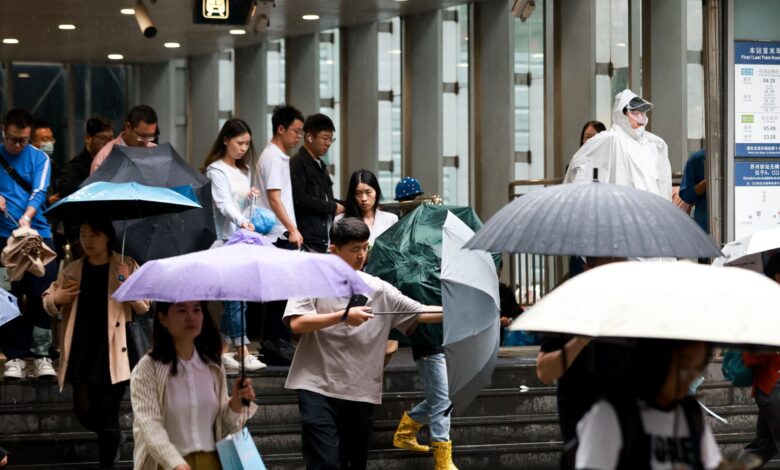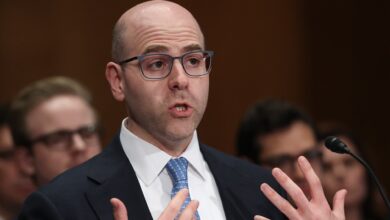China stimulus calls are growing louder — inside and outside the country

Local residents with umbrellas walk out of a metro station in rain during morning rush hour on September 20, 2024 in Beijing, China.
China News Service | China News Service | Getty Images
BEIJING — More economists are calling for China to stimulate growth, including those based inside the country.
China should issue at least 10 trillion yuan ($1.42 trillion) in ultra-long government bonds in the next year or two for investment in human capital, said Liu Shijin, former deputy head of the Development Research Center at the State Council, China’s top executive body.
That’s according to a CNBC translation of Liu’s Mandarin-language remarks available on financial data platform Wind Information.
His presentation Saturday at Renmin University’s China Macroeconomy Forum was titled: “A basket of stimulus and reform, an economic revitalization plan to substantially expand domestic demand.”
Liu said China should make a greater effort to address challenges faced by migrant workers in cities. He emphasized Beijing should not follow the same kind of stimulus as developed economies, such as simply cutting interest rates, because China has not yet reached that level of slowdown.
After a disappointing recovery last year from the Covid-19 pandemic, the world’s second-largest economy has remained under pressure from a real estate slump and tepid consumer confidence. Official data in the last two months also points to slower growth in manufacturing. Exports have been the rare bright spot.
Goldman Sachs earlier this month joined other institutions in cutting their annual growth forecast for China, reducing it to 4.7% from 4.9% estimated earlier. The reduction reflects recent data releases and delayed impact of fiscal policy versus the firm’s prior expectations, the analysts said in a Sept. 15 note.
“We believe the risk that China will miss the ‘around 5%’ full-year GDP growth target is on the rise, and thus the urgency for more demand-side easing measures is also increasing,” the Goldman analysts said.
China’s highly anticipated Third Plenum meeting of top leaders in July largely reiterated existing policies, while saying the country would work to achieve its full-year targets announced in March.
Beijing in late July announced more targeted plans to boost consumption with subsidies for trade-ins including upgrades of large equipment such as elevators.
But several businesses said the moves were yet to have a meaningful impact. Retail sales rose by 2.1% in August from a year ago, among the slowest growth rates since the post-pandemic recovery.
Real estate drag
China in the last two years has also introduced several incremental moves to support real estate, which once accounted for more than a quarter of the Chinese economy. But the property slump persists, with related investment down more than 10% for the first eight months of the year.
“The elephant in the room is the property market,” said Xu Gao, Beijing-based chief economist at Bank of China International. He was speaking at an event last week organized by the Center for China and Globalization, a think tank based in Beijing.
Xu said demand from China’s consumers is there, but they don’t want to buy property because of the risk the homes cannot be delivered.
Apartments in China have typically been sold ahead of completion. Nomura estimated in late 2023 that about 20 million such pre-sold units remained unfinished. Homebuyers of one such project told CNBC earlier this year they had been waiting for eight years to get their homes.
To restore confidence and stabilize the property market, Xu said that policymakers should bail out the property owners.
“The current policy to stabilize the property market is clearly not enough,” he said, noting the sector likely needs support at the scale of 3 trillion yuan, versus the roughly 300 billion yuan announced so far.
Different priorities
China’s top leaders have focused more on bolstering the country’s capabilities in advanced manufacturing and technology, especially in the face of growing U.S. restrictions on high tech.
“While the end-July Politburo meeting signaled an intention to escalate policy stimulus, the degree of escalation was incremental,” Gabriel Wildau, U.S.-based managing director at consulting firm Teneo, said in a note earlier this month.
“Top leaders appear content to limp towards this year’s GDP growth target of ‘around 5%,’ even if that target is achieved through nominal growth of around 4% combined with around 1% deflation,” he said.
In a rare high-level public comment about deflation, former People’s Bank of China governor Yi Gang said in early September that leaders “should focus on fighting the deflationary pressure” with “proactive fiscal policy and accommodative monetary policy.”
However, Wildau said that “Yi was never in the inner circle of top Chinese economic policymakers, and his influence has waned further since his retirement last year.”
Local government constraints
China’s latest report on retail sales, industrial production and fixed asset investment showed slower-than-expected growth.
“Despite the surge in government bond financing, infrastructure investment growth slowed markedly, as local governments are constrained by tight fiscal conditions,” Nomura’s Chief China Economist Ting Lu said in a Sept. 14 note.
“We believe China’s economy potentially faces a second wave of shocks,” he said. “Under these new shocks, conventional monetary policies reach their limits, so fiscal policies and reforms should take the front seat.”
The PBOC on Friday left one of its key benchmark rates unchanged, despite expectations the U.S. Federal Reserve’s rate cut earlier this week could support further monetary policy easing in China. Fiscal policy has been more restrained so far.
“In our view, Beijing should provide direct funding to stabilize the property market, as the housing crisis is the root cause of these shocks,” Nomura’s Lu said. “Beijing also needs to ramp up transfers [from the central government] to alleviate the fiscal burden on local governments before it can find longer-term solutions.”
China’s economy officially still grew by 5% in the first half of the year. Exports surged by a more-than-expected 8.7% in August from a year earlier.
In the “short term, we must really focus to be sure [to] successfully achieve this year’s 2024 growth goals, around 5%,” Zhu Guangyao, a former vice minister of finance, said at the Center for China and Globalization event last week. “We still have confidence to reach that goal.”
When asked about China’s financial reforms, he said it focuses on budget, regional fiscal reform and the relationship between central and local governments. Zhu noted some government revenue had been less than expected.
But he emphasized how China’s Third Plenum meeting focused on longer-term goals, which he said could be achieved with GDP growth between 4% and 5% annually in the coming decade.




